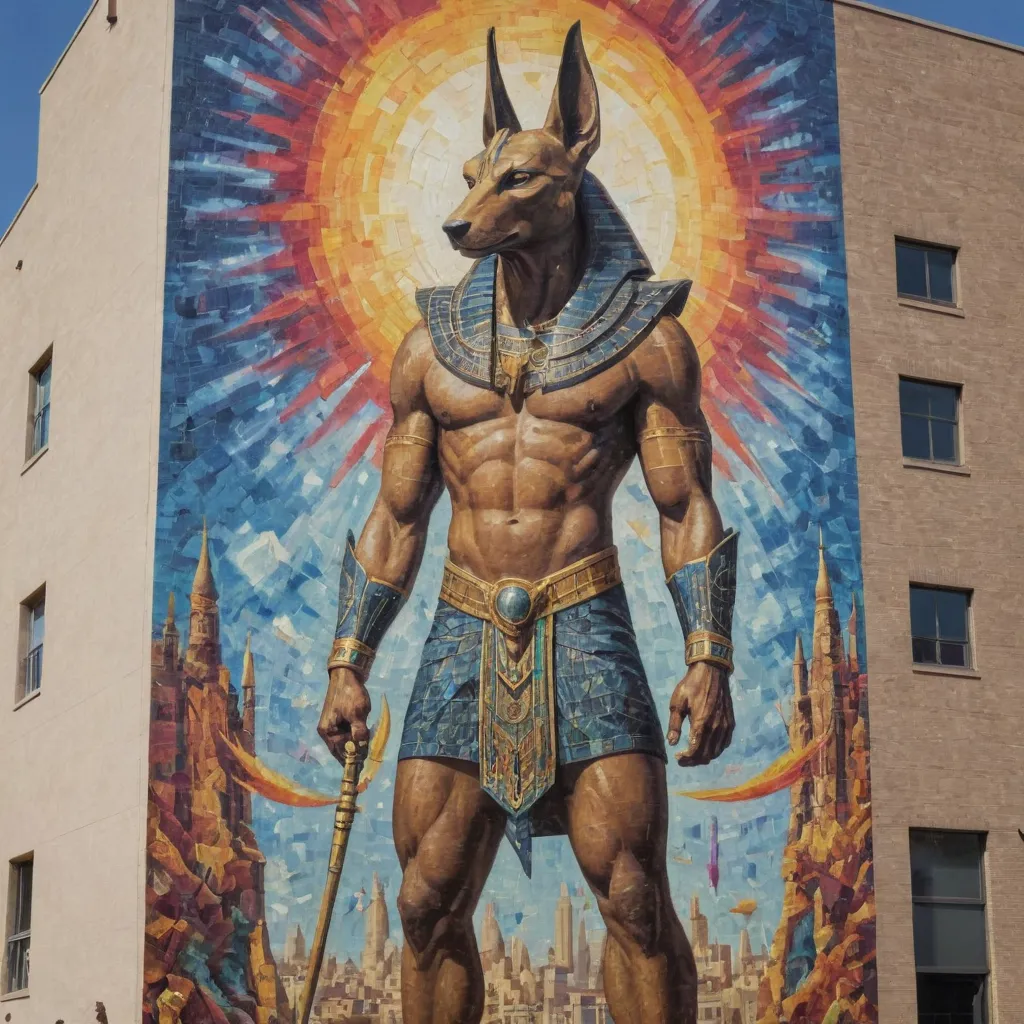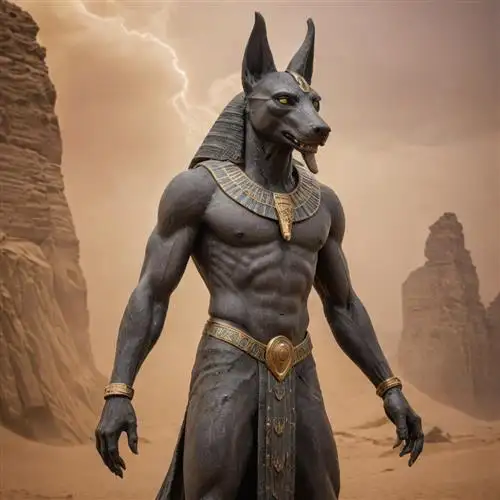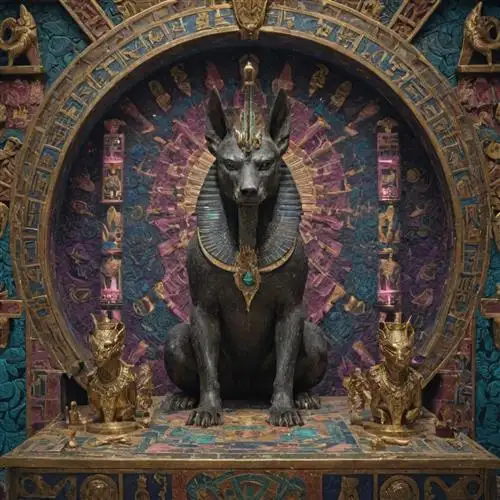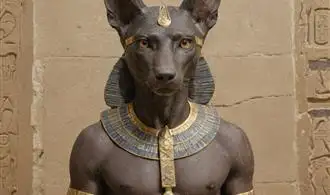
The Enigmatic Figure of Anubis
Anubis, the jackal-headed deity of ancient Egyptian mythology, has captivated the imagination of scholars and enthusiasts alike for centuries. As the patron god of mummification and the afterlife, Anubis played a crucial role in the intricate rituals and beliefs that defined the ancient Egyptian worldview. Delving into the rich iconography and symbolism associated with this enigmatic figure can provide profound insights into the cultural and spiritual landscape of the ancient Nile civilization.
One of the most striking aspects of Anubis' iconography is his unique animal representation. The jackal, or more specifically the African wild dog, was chosen as Anubis' sacred animal for its keen senses and ability to navigate the liminal spaces between the world of the living and the dead. This connection to the boundary between realms was integral to Anubis' role as the guide and protector of the deceased, ensuring their safe passage to the afterlife.
The black color of Anubis' skin is also highly significant, as it symbolizes both the fertile black soil of the Nile Valley and the decomposition of the body. This dual symbolism reflects the cyclical nature of life and death, with Anubis presiding over the transformation of the physical form into the spiritual realm. The color black, associated with the underworld and the night, further reinforces Anubis' connection to the realm of the dead and his role as a gatekeeper between the two worlds.
Anubis' iconography often depicts him in a variety of postures and contexts, each imbued with deep meaning. In some representations, he is shown standing upright, holding the was scepter and the ankh symbol, signifying his authority and his role as a guiding force for the deceased. In other instances, Anubis is shown kneeling or crouching, symbolizing his protective and nurturing nature as he oversees the mummification process or the weighing of the heart ceremony, a crucial step in the Egyptian afterlife journey.
The enigmatic nature of Anubis extends beyond his physical representation, as the deity's origins and the evolution of his cult have been the subject of ongoing scholarly debate. While some scholars believe Anubis may have originated as a local jackal-headed deity worshipped in the Cynopolis region, others argue that he was a later amalgamation of various canine-related deities throughout Egypt. Regardless of his precise origins, Anubis' enduring presence in the Egyptian pantheon and his central role in the complex funerary rites and beliefs of the ancient Egyptians are undeniable.
Symbolism and Meaning in Anubis Iconography
Anubis, the jackal-headed Egyptian deity, is a rich and complex figure in ancient Egyptian mythology, and his iconography is a treasure trove of symbolic meaning. As the god associated with mummification, the afterlife, and the protection of the dead, Anubis' visual representations hold profound significance for those seeking to understand the beliefs and practices of this ancient civilization.
One of the most striking aspects of Anubis' iconography is the jackal or dog-like head. This animal form is not merely an aesthetic choice but a deliberate symbolic representation. Jackals, known for their scavenging behavior, were believed to be the guardians of the necropolis, the ancient Egyptian burial grounds. Their presence at these sacred sites was seen as a natural connection to the realm of the dead, making them the perfect embodiment for the god who presided over the process of mummification and the transition to the afterlife.
The distinctive black color of Anubis' skin is another important element of his iconography. Black was a revered hue in ancient Egypt, associated with the fertile soil of the Nile River and the regenerative powers of the natural world. For Anubis, this color symbolized the decomposition and rebirth that were integral to the mummification process and the journey through the afterlife.
Anubis is often depicted holding specific objects or performing specific actions that further illuminate the symbolic meaning of his iconography. The god may be shown holding a was scepter, a symbol of power and authority, or a measuring tool, representing his role in the judgment of the dead. He may also be depicted embalming a mummy, underscoring his responsibility for the careful preparation of the deceased for the afterlife.
The positioning and pose of Anubis in Egyptian art can also convey important symbolic meaning. For instance, the god may be shown standing guard over a sarcophagus or sitting atop a funerary bier, suggesting his role as a protector and guide for the deceased. In some representations, Anubis is depicted kneeling or crouching, a posture that conveys a sense of reverence and humility before the sacred process of mummification and the journey to the afterlife.
Anubis in Art and Culture
Anubis, the enigmatic jackal-headed deity, has long captured the imagination of scholars, artists, and enthusiasts alike. As a central figure in ancient Egyptian mythology, Anubis' iconography is rich with symbolism and significance, revealing insights into the beliefs and practices of this ancient civilization. In this article, we'll delve into the realm of Anubis in art and culture, exploring the many facets of this captivating deity.
One of the most striking aspects of Anubis' iconography is the jackal or dog-like head that adorns his form. This distinctive feature is not merely a stylistic choice but rather a deliberate representation of the animal's importance in ancient Egyptian society. Jackals were revered for their keen senses, ability to navigate the underworld, and their role in the mummification process, making them a natural choice to symbolize Anubis, the guardian of the dead.
Anubis' depiction in art often showcases his role as a psychopomp, responsible for guiding the souls of the deceased to the afterlife. In funerary art, Anubis is frequently shown standing beside the deceased, overseeing the mummification process or presiding over the weighing of the heart ceremony, a pivotal moment in the journey to the afterlife. These scenes not only highlight Anubis' importance in the afterlife but also serve as a testament to the ancient Egyptians' profound reverence for the rituals and beliefs surrounding death and the hereafter.
Beyond the funerary context, Anubis' iconography has found its way into various aspects of ancient Egyptian art and culture. Statues and reliefs depicting Anubis have been discovered in temples, tombs, and other sacred spaces, underscoring his widespread veneration throughout the ancient kingdom. Interestingly, Anubis' association with the underworld and his role as a guide for the dead has led to his inclusion in various mythological narratives, further cementing his place as a central figure in the pantheon of ancient Egyptian deities.
One particularly fascinating aspect of Anubis' iconography is his connection to the symbolism of Anubis. The jackal-headed deity is often associated with themes of transformation, rebirth, and the cyclical nature of life and death. This symbolism has been explored in depth by scholars, shedding light on the profound philosophical and spiritual beliefs of the ancient Egyptians.
The Role of Anubis in Funerary Rites
Anubis, the jackal-headed Egyptian deity, played a pivotal role in the funerary rites of ancient Egypt. As the god of embalming and the protector of the dead, Anubis was a central figure in the complex rituals and ceremonies that guided the deceased on their journey to the afterlife.
One of the most significant responsibilities of Anubis was the mummification process. The ancient Egyptians believed that the preservation of the physical body was crucial for the soul's successful transition to the next life. Anubis oversaw the meticulous process of embalming, ensuring the body was properly prepared and protected for eternity.
During the mummification process, Anubis would lay the deceased on a funerary couch and perform the incision on the left side of the body, through which the internal organs were removed. These organs were then placed in canopic jars, each guarded by a different deity. Anubis would then carefully clean and anoint the body with sacred oils and wraps it in linen bandages, transforming the deceased into a mummy.
Anubis also played a crucial role in the funerary ceremonies and the journey to the afterlife. He was often depicted as a jackal guiding the deceased through the gates of the underworld, or standing vigilantly by the side of the deceased during the weighing of the heart ceremony. This ceremony, where the heart of the deceased was weighed against the feather of truth, determined the worthiness of the individual for the afterlife.
If the deceased's heart was found to be pure and in balance, Anubis would then escort the individual to the throne of Osiris, the ruler of the underworld. Anubis would serve as a protector and guide, ensuring the safe passage of the deceased through the treacherous realms of the afterlife.
Furthermore, Anubis was often depicted on funerary items, such as sarcophagi, canopic jars, and funerary masks. These representations served as a constant reminder of Anubis' role in the funerary rites and the protection he provided to the deceased in the afterlife.
Anubis in the Modern Imagination
Anubis Iconography - The Things I Wish I Had Known Sooner
Anubis, the enigmatic jackal-headed deity, has captivated the imagination of millions for centuries. As a symbol of the ancient Egyptian pantheon, Anubis's iconography has evolved over time, appearing in various forms and carrying profound meanings. In the modern age, Anubis's influence extends far beyond the confines of its ancient origins, permeating various aspects of popular culture and spiritual practices.
Anubis's iconic presence in the modern world is a testament to the enduring power of ancient Egyptian mythology. Unlike many other deities from the past, Anubis has maintained a strong foothold in contemporary thought and representation. This can be attributed to several factors, including the rise of neopaganism, the growing interest in esoteric and occult practices, and the pervasive influence of ancient Egyptian themes in popular media.
One of the most notable ways Anubis has emerged in the modern imagination is through its association with death and the afterlife. The jackal-headed deity's traditional role as the guardian of the dead and the embalming process has resonated with individuals and groups seeking to explore the mysteries of the beyond. Anubis's symbolic connection to the journey of the soul has made it a popular figure in various spiritual and metaphysical practices, ranging from Wiccan rituals to tarot card interpretations.
Beyond the realm of spirituality, Anubis has also found a place in contemporary art, literature, and popular culture. From Egyptian-inspired fashion lines to blockbuster films featuring the jackal-headed deity, Anubis's iconic image has become a readily recognizable symbol of ancient Egyptian culture. Anubis Iconography - A Beginner's Comprehensive Guide delves deeper into the artistic and symbolic representations of this profound figure.















